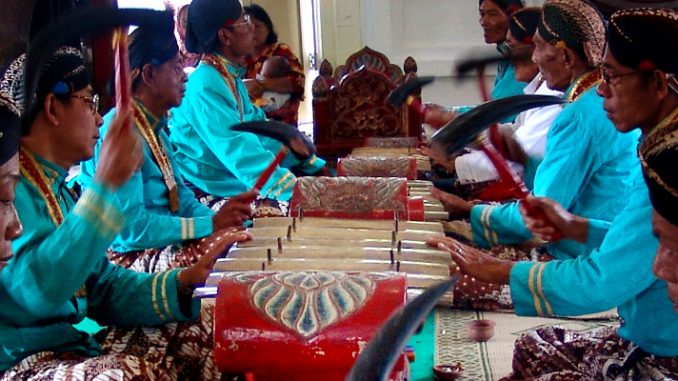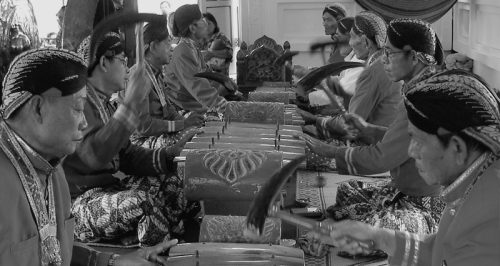
The festival of the birth of the Prophet in Indonesia begins on the sixth day of the month of Mawlid and ends on the twelfth day. It is one of the most important religious festivals in the world’s largest Muslim country. This religious celebration is held in three Indonesian royal courts: Yogyakarta, Surakarta, and Cirebon. My paper is a brief ethnographic account of the Muhammad’s birthday celebration in Yogyakarta.
On first day around 7 p.m., two sets of gamelan Sekati begin playing in the Yogyakarta palace, starting with the set Kyai Gunturmadu in pavalion Srimanganti, followed by the set Kyai Nagawilaga in the pavalion Trajumas. People then gather around these two pavilions to receive udhik-udhik or coins blessed by the sultan’s brother. Around 11 p.m., the gamelan Sekati is moved into two pavilions at the mosque accompanied by a military band as an honor guard. 1 The set Kyai Gunturmadu is placed in the southern pavilion of the Grand Mosque, and the set Kyai Nagawilaga is placed in the northern pavilion of the Grand Mosque. Once there, the music continues until midnight.
On the second through sixth days the gamelan sekati are played from 8 a.m. until midnight, except for during prayer time and the period from Thursday after 3 p.m. until Friday at 2 p.m. During the time that gamelan sekati is playing, people come to the two pavilions to deliver requests to the spirit in the gong. These requests take the form of kemenyan, or incense prayers. On the evening of the sixth day, the sultan comes to the Grand Mosque for the ceremonies of udhik-udhik and mawlid, which is the reading of the biography of Muhammad. He passes out the udhik-udhik to the commoners in the pavilion where the gamelan sekati are playing. This is considered to be the climax of the celebration. After that, the sultan attends the mawlid ceremony in the prayer hall and, finally, passes out the udhik-udhik in the prayer hall. Around 11 pm, the gamelan Sekati is moved back to the palace accompanied by the military marching band. On the seventh and final day, the sultan makes the offering of the Gunungan, or rice mountain. Again, people gather around to receive a piece of the sultan’s power and blessing.
Gamelan Sekati
Java has a history of accepting musical expression where stricter forms of Islam reject it. Gamelan has a long history in Java, dating back to at least the 12th century CE, though mythologies put it all the way back to the 3rd century CE. At the beginning of the festival of Muhammad’s Birthday, the first event to take place is the playing of gamelan Sekati. This music is the most persistent element in the weeklong festival. This degree of musical expression is typically forbidden by Islam. Sumarsam (1995) points out that the attitude towards music is different in Javanese Islam. Recorded in the Serat Centhini, a Javanese poem from the late 18th or early 19th century, is an explanation of how this attitude is unique in Javanese Islam. Sumarsam (1995, 91) explains that “what is condemned is not musical experience but the behavior that is associated with music. When the Serat Centhini attributes a positive value to music, it judges music to be not only legitimate but an experience that is synonymous with the highest form of religious ecstasy. This can all be achieved when one is equipped with proper knowledge of the music.”
The playing of gamelan Sekati is typically considered to be the most obvious difference between the festival of Muhammad’s birthday in Indonesia compared to other countries. It is traditionally believed that Sunan Kalijaga, one of the nine Islamic saints (Wali Songo) who brought Islam to Java, introduced gamelan Sekati to the people. Sunan Kalijaga used the name Sekati, which comes from Arabic Shahada, meaning the declaration of a Muslim who believes that there is no other god but God and that Muhammad is the messenger of God. Sunan Kalijaga adopted a traditional Javanese art to attract people to Islam. It is believed that this saint rearranged the instrumentation and amplified the size of the gamelan from the archaic gamelans, subsequently creating two sets of gamelan Sekati. According to my respondents, the enormity of this gamelan makes it louder than traditional gamelan and has the effect of bringing people from faraway places to hear the Islamic teachings.

Gamelan Sekati shares some compositional pieces with the regular gamelan and also has some special pieces that were created specially for the gamelan Sekati. The names bestowed upon these special pieces are considered to possess various meanings, which are derived from their Islamic connotations. For instance, the meaning of the piece gendhing Rambu is based on the name of the gending, a derivative form of the Arabic name of “Mulud.” The name Sobah is from the Arabic phrase subhan’allah, which denotes “Glory to God” (Toth 1970, 24).
One important element of the festival of Muhammad’s birthday is the presence of the gamelan Sekati instruments. These instruments fall into a special category of object known as pusaka. Pusaka are certain artifacts believed to be sacred and to have magical powers due to their origin, age, past ownership, or participation in an historical event. Pusaka are believed to have an inherent power and are sources of spiritual strength for those who possess them. Other types of pusaka could include weapons, flags, books, carriages, ceremonial objects, textiles, jewelry, ceramics, beads, land, ancestor figures, shadow puppets, and houses. It is noteworthy that, though pusaka are a major part of a king’s inheritance, a community, a nobleman or a common citizen may also possess pusaka (Vetter 1986, 129).
Kemenyan Prayer
Kemenyan is an incense used to provide an appropriate setting for communication with the spirits. It is used in two situations during the festival for Muhammad’s birthday. First, it is burned by an abdi dalem (palace servant) before the instruments are disturbed in any way (cleaning, moving, playing). Once the abdi dalem burns the incense, they can pray to the spirit in the gong asking it to remain at peace (Lee 2006, 55). Second, it is burned in a ceremony in which people ask the spirit in the gong to help them resolve their problems. This occurs while the gamelan Sekati are being played. In this ceremony, people give flower petals and incense wrapped in banana leaves to the abdi dalem. The abdi dalem puts the flower petals inside a basket beside the gong, and the incense in a clay pot to burn. When the incense starts to burn, the abdi dalem assists the people in passing their requests or problems to the guardian spirit inside of the gamelan Sekati. People believe they will receive blessings from the spirits inside the instruments, and after this process is over, they will be blessed with peace and happiness. This tradition is also related to the Javanese tradition of pusaka because it relies on the power of and the spirits in the gamelan Sekati to bring a blessing.

The Udhik-Udhik Offering
The ceremonial offering of udhik-udhik is usually held by the Sultan at the palace. The sultan offers coins, yellow rice, roses and jasmine, which are all blessed by the Islamic leader before the offering. People believe that if they receive the blessed coins, they will attain a good fortune. Beck (1995) and Tirtakoesonma (2003) believe that the practice of udhik-udhik is based on the Islamic percept of giving alms (zakat). Beck (1995, 274) points out that udhik-udhik which possess “magic power” will bring “good luck” to the recipient. He also notes that according to the Muhammadiayh, they are the sadaqa, or the Sultan’s “alms giving” to facilitate the propagation of Islam. However, the common people who wish to possess the udhik-udhik seem to regard them in a more traditional way. What the common people want to obtain is the sacred power from the coin. This idea of objects possessing and transferring sacred energy is very similar to the way the Javanese people regard their pusaka (sacred object/heirloom) tradition.

Gunungan: Blessed Rice Mountain
According to Bonnefoy and Doniger (1993, 174), the gunungan ceremony is “made up of a number of elements of pre-Indian origin, yet today it takes place three times a year on the principal Muslim feasts.” Gunungan, which literally refers to “rice mountain,” consists of cooked rice, eggs and fruit. The offering of gunungan is from the Sultan, who first has the food blessed by the Islamic leader and then offers it to the citizens. This tradition has the practical effect of maintaining good relations between the ruler and the citizens. After the rice mountain has been carried to the mosque, there is a prayer ceremony where people are offered various objects. The people wait excitedly while the prayers are made, then, after the prayers are finished, people crowd around the gunungan and eagerly grab the food from the “rice mountain.”

On the last day of the festival for Muhammad’s birthday, the sultan presents gunungan to his people. Like udhik-udhik, the people wish to receive food from these rice mountains because they contain the blessing and spiritual power of the divine. The origin and meaning of this practice are linked back to the ancient Javanese myth of Jaka Tarub and Nawang Wulan. 2 Nawang Wulan is said to be a form of the rice goddess Dewi Sri and when the ruler of Surakarta cooks the rice he is said to use the dandang (rice cooker) of Nawang Wulan (Kumar 2009, 135). Akin to udhik-udhik, gunungan fits nicely into the Islamic practice of alms giving (Beck 1995, 274).
Mawlid: Reciting the Biography of Muhammad
Mawlid is a ceremony held by the Sultan, which is primarily meant for reciting the biography of Muhammad to commemorate the prophet. During this ceremony held at the great mosque, the Sultan starts with the udhik-udhik offering. Next, the Sultan gives a hint to the Pangulu (the highest ranking religious head of the court) to read the biography of Muhammad. The ceremony ends with a benediction ritual (Beck 1995, 266).

Concluding Remarks
In the case of the Prophet Muhammad’s birthday, an Islamic festival is celebrated with the music and popular practices of the Javanese society. Vetter (1986, 133) suggests that the use of Javanese gamelan “has been altered in such ways as to glorify the Islamic facet of Sekati rather than this ceremony’s relationship to the traditional statecraft.” Therefore it is no surprise that Gamelan Sekati, incense burning, and the distribution of blessed coins and rice mountain were integrated into an important Islamic celebration to draw people to the mosque and inspire them with Islamic teachings.
Historians have pointed out that Javanese rulers always understood the importance of continuity of tradition. Each time a new framework of beliefs was adopted, many of the old traditions were retained. As Beck (1995, 273) points out, “Some of [Sekaten] elements resemble the Hindu Rajawada ritual, or ‘royal sacrifice; offering of food’, and the Hindu Asmawada, a ritual with lauds, dances, music and prayers in honour of the ancestral sprits.” This retention of old elements makes the new situation much easier for the average citizen to accept and invest in. It is this ecumenical spirit, perhaps, that has kept the Javanese people so interested in the culture of the court.
Ming-yen Lee
Ming-yen Lee is Assistant Professor of Ethnomusicology at Nanhua University. Her research interests include modern Chinese orchestra, Chinese music, Indonesian music, and Buddhist music.
This paper is based on my fieldwork in Yogyakarta. I am grateful to Jack Meng-Tat Chia and Ben Marquis for their comments and suggestions. All photos in this article are mine.
YAV, Issue 20, Kyoto Review of Southeast Asia. Febrary 2017
References
Beck, Herman. 1995. “Islamic Purity at Odds with Javanese Identity: The Muhammadiyah and the Celebration of the Garebeg Maulud Ritual in Yogyakarta.” Pluralism and Identity: Studies in Ritual Behaviour, edited by JanPlatvoet and Karel van der Toorn, 261-284. Leiden; New York; Koln: Brill.
Bonnefoy, Yves and Wendy Doniger. 1993. Asian Mythologies. Chicago: University of Chicago Press.
Geertz, Clifford. 1976. The Religion of Java. Chicago: University of Chicago Press.
Graves, Elizabeth E. 1981. The Minangkabau Response to Dutch Colonial Rule in the Nineteenth Century. Ithaca, New York: Cornell University.
Kumar, Ann. 2009. Globalizing the Prehistory of Japan: Language, Genes and Civilization. New York: Routledge.
Lee, Ming-yen. 2006. “Traditional Music Practice in Islamic Religious Ceremony: Gamelan Sekati as Celebration for Muhammad’s Birthday in Indonesia’s Yogyakarta Palace.” Master thesis, National Taiwan University.
Sumarsam. 1995. Gamelan: Cultural Interaction and Musical Development in Central Java. Chicago: University of Chicago Press.
Terada, Alice M. 1994. The Magic Crocodile and Other Folktales from Indonesia. Honolulu: The University of Hawaii Press
Tirtakoesoema, Soedjana. 2003. “The Celebration of Garebeg Mulud Dal 1863 inYogyakarta.” The Kraton: Selected Essays on Javanese Courts, edited by StuartRobson, translated by Rosemary Robson-McKillop, 107-130. Leiden: KITLV Press.
Toth, Andrew. 1970. “The Gamelan Sekati of Central Java.” Master thesis, Wesleyan University.
Vetter, Roger. 1986. “Music For ‘The Lap of the World’: Gamelan Performance.
Performers, and Repertoire in the Kraton Yogyakarta.” Ph.D. dissertation, University of Wisconsin-Madison.
Woodward, Mark. 1989. Islam in Java: Normative Piety and Mysticism in the Sultanate of Yogyakarta. Tucson: University of Arizona Press.
Notes:
- The use of a military band in state ceremonies was adopted from the Dutch. ↩
- Jaka Tarub was walking through the woods one day when he heard the sound of girls laughing. Following the sound, he came across a group of angels bathing. Before they discovered him, he hid one of their shawls. When they all flew away, Nawang Wulan stayed behind, not being able to leave without her shawl. Jaka Tarub stepped out and comforted her and convinced her to come home with him. In time, she became his wife. Nawang Wulan had certain magic powers, one of which was to be able to produce unlimited amounts of rice from her magic rice cooker. She repeatedly warned him never to look inside of her rice cooker. One day, she was called away and Jaka Tarub’s curiosity won him over and he looked into the rice cooker and found it to contain one grain of rice. After this, the spell was broken. Thereafter, they began to use the rice in the storehouse very quickly. One day, when Nawang Wulan went out to get rice, she took the last of it and discovered her shawl at the bottom of the pile where Jaka Tarub had hidden it. She took her shawl and flew away, never to return (Terada 1994, 69-70). ↩
